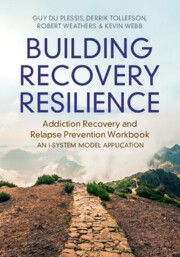 Building Recovery Resilience
Building Recovery Resilience Book contents
- Building Recovery Resilience
- Building Recovery Resilience
- Copyright page
- Contents
- Introduction
- 1 Dealing Effectively with High-Risk Situations
- 2 Coping with Cravings and Triggers
- 3 You Can’t Fix What’s Not Broken
- 4 Break the Addiction Cycle
- 5 The Requirements That Bind Us
- 6 Your Recovery Resilience Practice
- References
- Notes
- Index
3 - You Can’t Fix What’s Not Broken
Published online by Cambridge University Press: 28 May 2024
- Building Recovery Resilience
- Building Recovery Resilience
- Copyright page
- Contents
- Introduction
- 1 Dealing Effectively with High-Risk Situations
- 2 Coping with Cravings and Triggers
- 3 You Can’t Fix What’s Not Broken
- 4 Break the Addiction Cycle
- 5 The Requirements That Bind Us
- 6 Your Recovery Resilience Practice
- References
- Notes
- Index
Summary
There is a strong link between our capacity to cope with negative emotional states and their associated negative thoughts and substance use relapse. When individuals use substances as a coping mechanism this strategy may be effective in the short term and but proves maladaptive in the long run. The use of drugs provides both negative reinforcement (namely, the reduction of painful feelings via self-medication), and positive reinforcement (that is, the pleasant experience of being high via positive outcome expectancies). The self-medication hypothesis applies when the individual is using a substance to cope with negative emotions, conflict, or stress (negative reinforcement). From a positive outcome expectancy perspective, the person is focusing on the positive aspects and euphoria of using a substance (positive reinforcement), while ignoring the negative consequences. Therefore, an essential component of recovery is learning healthy ways to self-soothe and cope with stress and painful emotions, and the negative thoughts and rumination associated with them. Without healthy coping skills, a key component of recovery capital, individuals in recovery will continue to seek dysfunctional ways to self-regulate. In this chapter the reader is introduced to one of the causes behind negative rumination and over-compensatory behaviour that accompanies it, which perpetuates the cycle of addiction.
Keywords
- Type
- Chapter
- Information
- Building Recovery ResilienceAddiction Recovery and Relapse Prevention Workbook – An I-System Model Application, pp. 72 - 107Publisher: Cambridge University PressPrint publication year: 2024


